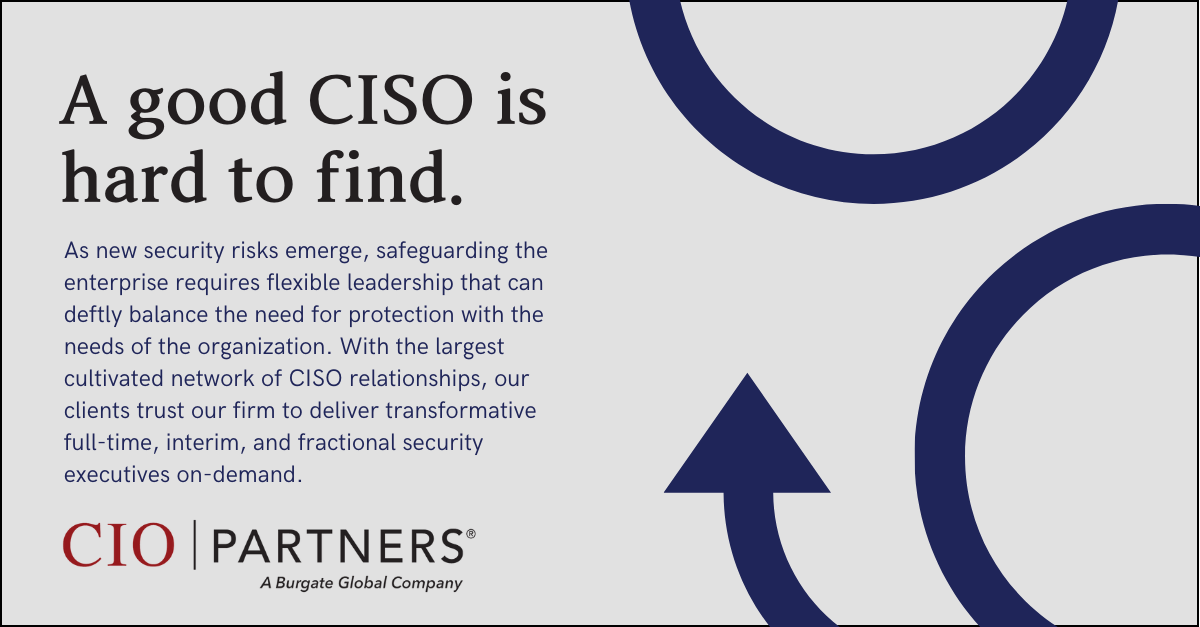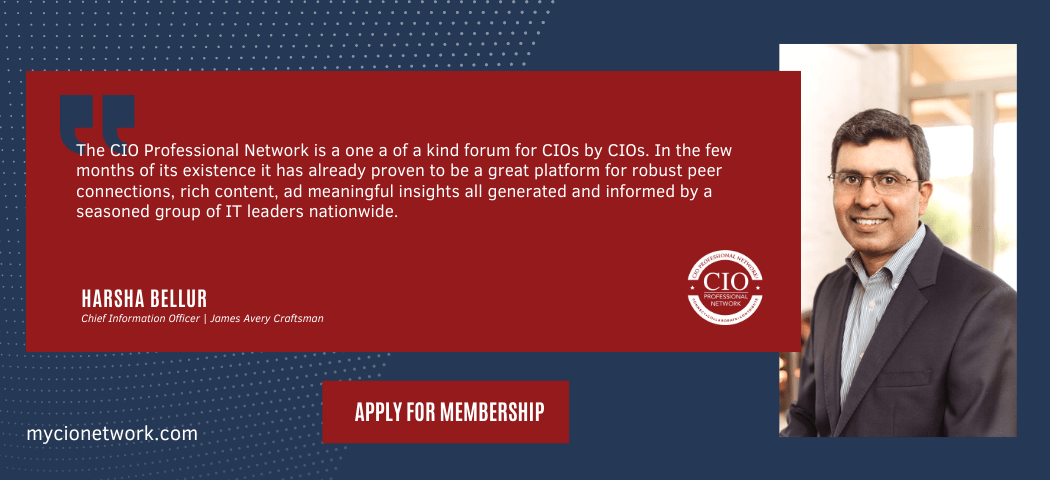Finding and hiring the right Chief Information Security Officer (CISO) is a formidable challenge for most companies. Organizations not only need a security leader who possesses deep technical expertise, but also one with strategic vision, and strong leadership skills to align security initiatives with business objectives.
The stakes are high, as the right CISO can significantly bolster an organization’s defenses, while the wrong choice can leave it vulnerable to cyber attacks.
The challenge is further compounded by the increasing frequency and sophistication of cyber threats, which have driven up the demand for seasoned cybersecurity leaders, creating a highly competitive talent market. Additionally, the shortage of qualified candidates exacerbates the problem, as many experienced CISOs are opting for fractional or interim roles to mitigate personal risks associated with high-profile breaches. This trend, coupled with the increasing complexity of the role, makes it difficult for companies to find and retain top talent.
Adding to the urgency, regulatory bodies are imposing stricter fines and penalties on organizations that fail to protect sensitive data. High-profile breaches can lead to substantial financial losses, legal repercussions, and damage to an organization’s reputation. In this context, having a dedicated security leader is not just a luxury but a necessity for modern businesses.
As organizations strive to fill this critical position, they must navigate a shrinking pool of qualified candidates and adapt their recruitment strategies to attract the best.
Understanding the Role of a CISO
A CISO is responsible for developing and implementing an organization’s information security strategy, overseeing security operations, and ensuring compliance with relevant regulations. This role requires a blend of technical expertise, strategic vision, and leadership skills.
CISOs must not only protect against cyber threats but also align security initiatives with business objectives.
Security Strategy Development: A CISO must develop and implement a comprehensive security strategy that aligns with the company’s overall business objectives. This involves identifying potential threats, evaluating the company’s current security posture, and designing measures to mitigate risks. This strategy should encompass all aspects of cybersecurity, including network security, application security, data protection, and incident response.
Regulatory Compliance: Ensuring compliance with industry standards and government regulations is a critical part of a CISO’s role. This includes staying abreast of the latest regulatory requirements, such as GDPR, HIPAA, and CCPA, and implementing necessary controls to ensure the organization remains compliant. Failure to comply can result in hefty fines and damage to the organization’s reputation.
Risk Management: A CISO must conduct regular risk assessments to identify and evaluate potential threats to the organization’s information assets. This involves assessing vulnerabilities in the organization’s infrastructure, applications, and processes, and implementing controls to mitigate identified risks. Risk management is an ongoing process that requires continuous monitoring and updating of security measures to address emerging threats.
Incident Response: In the event of a security breach, a CISO is responsible for managing the incident response process. This includes coordinating with internal and external stakeholders, containing the breach, conducting a thorough investigation to identify the cause, and implementing measures to prevent future incidents. A well-prepared incident response plan is essential for minimizing the impact of security breaches.
Collaboration with Executive Leadership: A CISO must work closely with the organization’s executive leadership team to ensure that security initiatives support business objectives. This involves regularly communicating the organization’s security posture, presenting risk assessments, and making recommendations for improving security. Effective communication skills are essential for translating technical security issues into business terms that can be understood by non-technical stakeholders.
Leadership and Team Management: Managing a team of security professionals is a key responsibility of a CISO. This includes recruiting and retaining top talent, providing ongoing training and development opportunities, and fostering a culture of security awareness within the organization. A CISO must also lead by example, demonstrating a commitment to security best practices.
Technology and Innovation: A CISO must stay abreast of the latest advancements in cybersecurity technologies and methodologies. This includes understanding emerging threats, new security tools and technologies, and innovative approaches to threat detection and prevention. A forward-thinking CISO leverages these advancements to enhance the organization’s security posture.
Budgeting and Resource Allocation: A CISO is responsible for developing and managing the organization’s cybersecurity budget. This involves allocating resources effectively to ensure that security initiatives are adequately funded and that the organization’s security infrastructure is robust and capable of defending against threats.
Security Awareness and Training: A CISO must develop and implement security awareness programs to educate employees about the importance of cybersecurity. This includes training employees on how to recognize and respond to security threats, as well as promoting a culture of security within the organization.
The Cost of a Vacant CISO Seat
An empty CISO position can be perilously costly for an organization.
Beyond the strategic void left by an unfilled role, this can also lead to increased vulnerabilities, delayed security initiatives, and potential regulatory non-compliance.
The absence of leadership can also negatively affect the morale and productivity of cybersecurity teams, further exacerbating the challenges of maintaining a robust defense against cyber threats.
Joe Gross, President of CIO Partners, a leading executive search firm for security technology leadership talent, emphasizes the significance of promptly filling CISO vacancies. “An empty CISO seat doesn’t merely represent a gap in leadership; it signifies a critical vulnerability in an organization’s ability to innovate and protect its stakeholders. Failing to promptly and effectively fill this role can expose a company to not just immediate security risks, but long-term strategic setbacks.”
In short, time is of the essence.
Defining the Ideal Candidate
Identifying the right candidate involves a careful assessment of their technical skills, leadership abilities, and regulatory knowledge. A CISO must possess a deep understanding of information security technologies and practices, including firewalls, intrusion detection systems, encryption, and network security protocols.
Beyond technical skills, a security leader should have the ability to develop long-term security strategies that align with the company’s goals. This involves risk management, policy development, and the ability to foresee and mitigate potential security threats.
Effective communication with both technical teams and executive leadership is essential. A CISO must be able to articulate security risks and strategies in a way that is understandable to non-technical stakeholders.
Leadership skills are crucial for managing security teams and driving organizational change.
Conducting the Search
Conducting an effective search for a CISO involves multiple steps and strategies to ensure the best candidates are identified and evaluated. The following approaches can help organizations conduct a thorough and successful search:
Internal vs. External Hiring: Decide whether to promote from within or seek external candidates. Internal candidates may have a better understanding of the company’s culture and existing security measures. However, external candidates can bring fresh perspectives and new expertise.
Leverage Professional Networks: Utilize professional networks and associations to find potential candidates. Attending industry conferences and events can also help in identifying and networking with qualified professionals. These platforms provide access to a broad pool of security professionals and can facilitate introductions to potential candidates.
Industry-Specific Job Boards: Utilize industry-specific job boards like IT LeaderBoard, which focus on leadership roles within technology and cybersecurity. These platforms cater to a niche audience, increasing the likelihood of finding candidates with the specialized skills and experience required for the CISO position.
Executive Search Firms: Consider partnering with executive search firms that specialize in high-level security roles. Firms like CIO Partners, which focus exclusively on technology leadership, offer the advantage of a deep understanding of the domain and a robust network of information security professionals. These firms can manage the recruitment process from end to end, ensuring that only the most qualified candidates are presented for consideration.
The Interview Process
The interview process for a CISO should be thorough and multifaceted, assessing both technical and strategic capabilities as well as cultural fit. Evaluate the candidate’s technical skills through practical assessments or scenario-based questions. This can include case studies on recent cybersecurity incidents and how they would handle them.
Assess the candidate’s ability to align security initiatives with business goals. Ask about their experience in developing and implementing security strategies and their approach to risk management.
Ensure the candidate aligns with the company’s values and culture through behavioral interview questions and discussions about their leadership style and teamwork. Conduct thorough reference checks to verify the candidate’s credentials and past performance.
Onboarding and Integration
Structured onboarding and integration is essential to ensure the new leader’s success. Provide an onboarding process that includes introductions to key stakeholders, an overview of current security policies, and a detailed briefing on the company’s security posture. Offer continuous support and resources to help the new CISO succeed, including ongoing training, access to industry events, and opportunities for professional development.
Clearly communicate expectations and key performance indicators (KPIs) from the outset. Regular check-ins and performance reviews can help ensure the leader and their team is meeting the organization’s security objectives.
By providing a supportive environment and clear expectations, organizations can help their new CISO integrate smoothly and start making impactful contributions quickly.
Compensation and Benefits
Compensation should reflect the level of responsibility and expertise required for the role. According to industry standards, the base salary for a CISO can vary significantly depending on the size and location of the company. In the United States, the median salary for a CISO is approximately $229,633, with total compensation (including bonuses and benefits) averaging around $365,140.
Startups may also offer equity as part of the compensation package to attract top talent.
A Bachelor’s or Master’s degree in Information Technology, Computer Science, or a related field is typically required. Relevant certifications, such as CISSP, CISM, CISA, and CRISC, are also highly valued. These certifications demonstrate a candidate’s commitment to ongoing education and adherence to industry best practices.

“An empty CISO seat doesn’t merely represent a gap in leadership; it signifies a critical vulnerability in an organization’s ability to innovate and protect its stakeholders. Failing to promptly and effectively fill this role can expose a company to not just immediate security risks, but long-term strategic setbacks.”
Joe Gross, CIO Partners
Navigating the CISO Talent Gap
The growing demand for experienced CISOs has led to a shrinking pool of available talent for permanent roles. Many professionals are gravitating towards fractional or interim positions to minimize personal liability and manage the intense pressures associated with high-profile breaches.
This trend necessitates a shift in strategies to not only attract, but retain top talent.
Organizations should consider expanding insurance coverage to include personal liability for cybersecurity incidents. This enhanced support can significantly alleviate the personal risks CISOs face, making permanent positions more attractive despite the allure of fractional roles.
By offering comprehensive insurance packages that protect against the financial and legal repercussions of potential breaches, organizations can demonstrate a commitment to their cybersecurity leaders’ well-being, distinguishing themselves as employers of choice in a competitive talent market.
Future Trends in CISO Hiring
As the role of the CISO evolves, several trends are emerging that will shape the future of hiring for this crucial position. While technical skills remain essential, there is a growing emphasis on soft skills such as communication, leadership, and strategic thinking.
CISOs need to effectively convey complex security issues to non-technical stakeholders and lead cross-functional teams as they are increasingly expected to understand and contribute to broader business objectives.
This requires a blend of security expertise and business acumen, enabling them to align security strategies with organizational goals and drive value creation. For smaller organizations or those with limited resources, hiring a full-time leader may not be feasible. The concept of a fractional CISO—where an experienced security leader is brought in on a part-time or interim basis—is gaining traction as a flexible and cost-effective solution.
The integration of AI and automation into cybersecurity practices is further transforming the role. Future CISOs will need to be proficient in leveraging these technologies to enhance threat detection, response times, and overall security efficiency.
Staying ahead of these trends will be crucial for organizations looking to hire effective CISOs.
The Wrap
As technology continues to advance and cyber threats become more sophisticated, the role of the CISO will become increasingly vital. Organizations must adopt a proactive approach to cybersecurity, starting with the strategic hiring of a CISO.
The evolving role of the CISO is critical to the sustained success and security of any organization, making the hiring process for this position one of the most important decisions a company can make.
Forward-thinking CEOs and their boards are evolving their strategies for attracting and retaining the leaders who safeguard the enterprise, ensuring their organizations remain resilient in the face of cyber threats.









